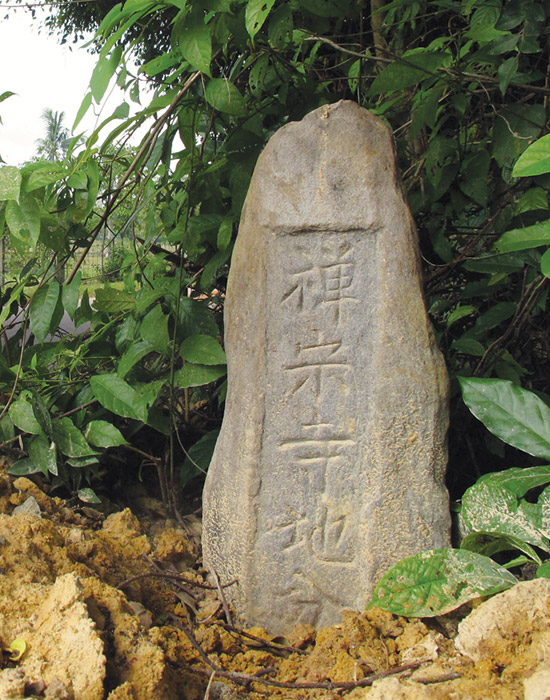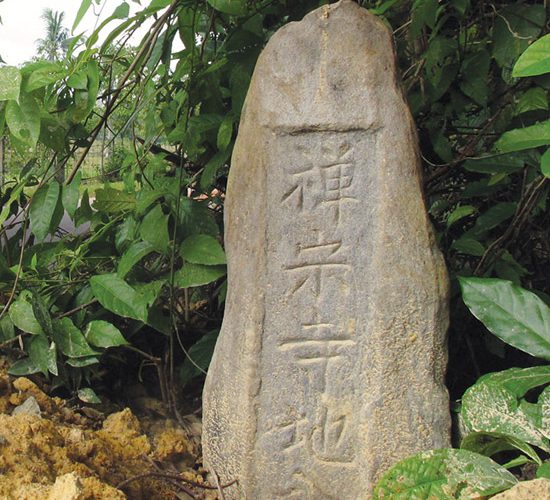(No.3, Vol.4, Apr-May 2014 Vietnam Heritage Magazine)

Stone steles at Thien Tong Pagoda

Hai Cat Village, Hue and Phu Duong Commune

Phu Vang District, near Hue
The locals told us that the brownish stone stele with Chinese words carved into it that mean ‘Stone Deity’, sitting under a lone coral tree in Thuong Village, Nguyet Bieu Commune, Hue, has been there for a long, long time. ‘Our ancestors passed on [to us] that wild beasts used to come and disturb our peace. The village invited a shaman to install the stone stele as a guard at the village entrance. Peace returned since then,’ Thuong Village elder Ho Huu Dinh relates.
Mr Dinh also said that because Nguyet Bieu Commune borders both a river and a forest, the stone has to be sacred and ascendant enough to protect the villagers from various dangers. Before each peace-seeking ritual or on New Year’s Eve at Thuong village, a village elder in ceremonial dress would bring offerings to ‘invite his sacredness’ to the village temple for a great feast.
Opposite from Nguyet Bieu, across the Perfume River, Hai Cat Commune also has a stone stele, with the carved words, ‘Thai Son Stone Deity’. Mr Tran Quang Nhon, who lives nearby, told us that this ‘deity’ was installed by their heroic ancestors from Thanh Hoa, who followed Lord Nguyen in the great southward expansion (in 16th century) both to be a landmark and to protect the settlers in a newly conquered land.
Those are two among tens of sacred stones that we found alongside the roads in Hue and the adjacent villages in our field trip with cultural researcher Ho Tan Phan. Some of them, like the one on a sidewalk of Chua Ong road, bear a carving that states the mission of the deity is to fend off all harm.
Many stones, which are called ‘deity’ by villagers, are just to mark border lines, such as the ones in Nguyen Trai Road in Hue An Commune, on Hung Vuong Road in Eighth Commune, and on Thien Thai Road outside the Thien Tong Temple.
Some stones have no carving, but nevertheless do have an altar and a story passed down by word of mouth, like the ‘Stone Lady’ in My An Village, Phu Duong Commune, Phu Vang District, the ‘Sacred Stone’ at Cau Bazaar – Phu Luong, Quang Thanh Commune, Quang Dien District, and many others that are scattered around Hue.
Early in the 20th century, priest-scholar Léopold Cadière (1869-1955), the initiator of a Hue research project, had spent much time to study in and around Hue citadel. He was quite surprised to have found that stone worship was very widespread. His research notes were published in the journals of the time.
He wrote, ‘One of the most widespread forms of worship, at least in certain areas, is stone worship and tree worship. The Vietnamese worship the rocks that may cause danger for those who travel on water, which means they beg the hostile deity nested in the stone not to harm them. They believe some stones are inhabited by a deity. That may be due to the special shape of the stone, or to its somewhat miraculous origin. But most of the stones are very ordinary.’*
This scholar also noted, ‘It’s hard to say whether the worship is dedicated to a specific deity housed in the stone, or to the stone itself because it is believed to possess a supernatural power.’
Nowadays, as many elders remember, quite a number of ‘deities’ have been lost, especially because of urban development, digging and levelling of roads and the encroaching of sidewalks. Perhaps, because of their shapes and the carved Chinese words, the stones become altars where people offer various things to those in the Ying world during the ending period of the lunar year. Around the stones, one can always see piles and piles of offerings to the lady and lord of the kitchen; thuribles, flower vases, and lime pots (for chewing with betel).
Cultural researcher Ho Tan Phan said, ‘It would be a pity if the stone system gets lost in the development process, because it has become evidence of the cultural and spiritual life of Vietnamese that the future generations should know about.’
*V?n hoá, tôn giáo, tín ng??ng Vi?t Nam d??i nhãn quan h?c gi? L.Cadière (Vietnamese Culture, Religion and Beliefs in the Eyes of L.Cadière), Do Trinh Hue, Thuan Hoa Publishing House, June, 2006

